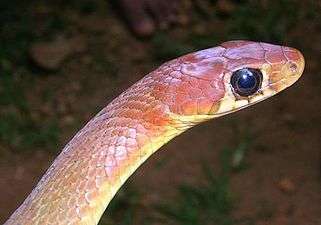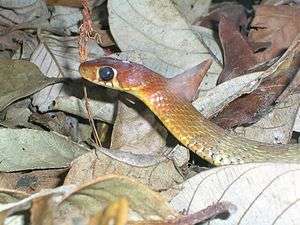Hebius monticola
Hebius monticola is a harmless colubrid snake species endemic to the Western Ghats of India. They are especially well known from the Kodagu and Wayanad regions of the Western Ghats.
| Hebius monticola | |
|---|---|
 | |
| Scientific classification | |
| Kingdom: | Animalia |
| Phylum: | Chordata |
| Class: | Reptilia |
| Order: | Squamata |
| Suborder: | Serpentes |
| Family: | Colubridae |
| Genus: | Hebius |
| Species: | H. monticola |
| Binomial name | |
| Hebius monticola (Jerdon, 1853) | |
| Synonyms[2] | |
| |
- Common names: hill keelback, mountain keelback, Wynad keelback.
Description

Adults are small and slender and found in leaf litter in forest habitats. The head is reddish. The body is brownish with a greenish gloss, while some individuals are bright green.
This species has 19 keeled dorsal scale rows at midbody, 133–144 ventrals. The anal scale is divided, and it has 78–92 subcaudals, which are also divided. There are 8 supralabials with the 3rd, 4th and 5th touching the eye. There is one preocular scale.[3]
Description from G. A. Boulenger, The Fauna of British India, Including Ceylon and Burma:[4]
Eye large, its diameter more than its distance from the nostril; rostral just visible from above; suture between the internasals shorter than that between the prefrontals; frontal considerably longer than its distance from the end of the snout, as long as the parietals; loreal as long as deep, or deeper than long; one preocular; three postoculars; temporals 2 + 2; upper labials 8, third, fourth, and fifth entering the eye; 5 lower labials in contact with the anterior chin shields, which are a little shorter than the posterior chin shields.
Scales in 19 rows, strongly keeled, except for those in the outer row which are smooth or feebly keeled. Ventrals 134–142; anal divided; subcaudals 80–92.
Green above, with black crossbands divided on each side by a pale spot; a white line across the head behind the eyes, and a white dot on each side of the frontal; preoculars, postoculars, and labials 3 to 6, all white; lower parts white.
Total length 45 cm (18 inches), tail 14 cm (5½ inches).
References
- Srinivasulu, C.; Srinivasulu, B. & Shankar, G. (2016). "Hebius monticola". IUCN Red List of Threatened Species. 2016: e.T172633A96310193. doi:10.2305/IUCN.UK.2016-1.RLTS.T172633A96310193.en.
- Hebius monticola at the Reptarium.cz Reptile Database
- Whitaker and Captain, 2004
- Boulenger, G.A. 1890. The Fauna of British India, Including Ceylon and Burma. Reptilia and Batrachia. Secretary of State for India in Council. (Taylor and Francis, Printers). London. xviii + 541 pp. (Tropidonotus monticola, p. 348.)
Further reading
- Jerdon, T.C. (1853) Catalogue of the Reptiles inhabiting the Peninsula of India. Part 2. J. Asiat. Soc. Bengal xxii: 522-534.
- Whitaker, R. and Ashok Captain (2004) Snakes of India: The Field Guide. Draco Books, Chennai.
